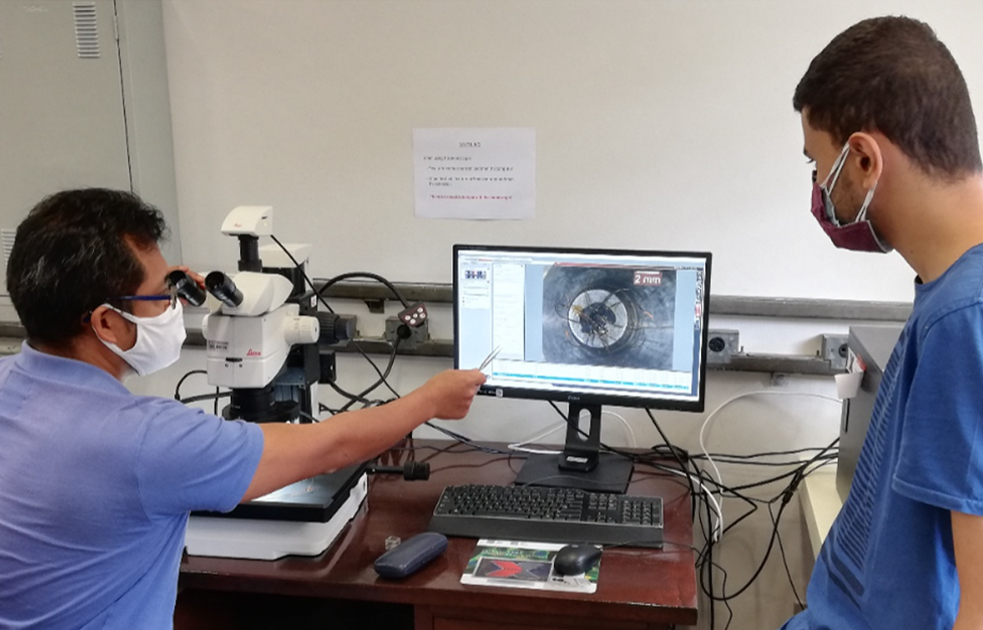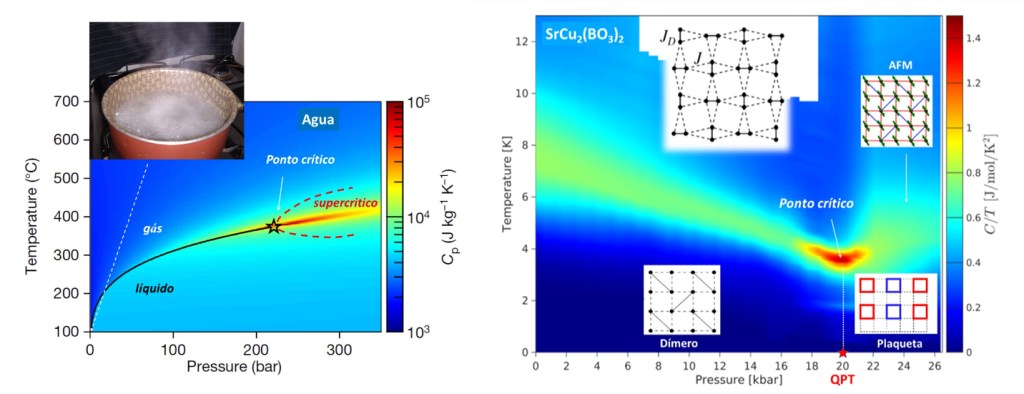By Júlio Bernardes

In physics, quantum systems are those in which the behavior of molecules, atoms, and particles cannot be described by any classical model. An example is a quantum system of spins. A spin may be defined as the quantum manifestation of the rotation of electrons (which are particles with electrical charges inside atoms). When several electrons present the same rotation, i.e., the same spin, it is said that the entire system is in the same state, which is called the quantum phase. Changes between quantum phases or quantum phase transitions may occur under extreme conditions of very low temperatures and high pressure and magnetic fields, which renders it impossible to measure their properties such as heat (amount of energy) through traditional techniques.
At the USP Institute of Physics (IF), an experiment conducted by professor Júlio Larrea with international collaboration tested an innovative technique for measuring with high precision the heat that exists in a quantum system with temperatures near absolute zero (negative 273 degrees Celsius), high pressures, and intense magnetic fields. Through the method, the physicists verified that the phase transitions in a quantum system of spins have characteristics similar to those of the passing of water from the gas state to the liquid state. The work results may aid the development of applications that require transporting energy without losses, such as computational systems with extremely high processing capacity, for which it is necessary to measure the energy retained in the form of heat.

The work is presented in an article published on the website of the Nature journal on April 14 of this year. The experiment results show that the phase transition in the quantum system of spins, when the state change occurs, is similar to what happens when water goes from the liquid state to the gas state.
“When water boils to 100 degrees Celsius, at atmospheric pressure, we observe that the liquid changes into gas, i.e., vapor; however, in this phase transition that begins at lower pressures and temperatures, liquid and gas coexist at the same time, causing an abrupt jump in the density of the particles, called by physicists a first-order phase transition or discontinuous phase transition”, explains the professor to the Jornal da USP. “In the quantum system of spins, in which the quantum phase transition occurs at absolute zero temperature, at a critical pressure, two spin states, i.e., two different rotations of the electrons, coexist simultaneously, indicated by a discontinuous jump in the density of the spins, which is classified as a first-order quantum phase transition.”
According to Larrea, in water, with the increase in temperature and pressure (to levels higher than atmospheric pressure), the first-order phase transition ends at a pressure and temperature level called the critical point for water. “At this moment, there is no more abrupt change in the density of particles due to the formation of a single state, called the superfluid state. This critical point is called a second-order transition or continuous order transition”, he reports. “In the quantum system of spins, the first-order phase transition also ends at a critical point. The difference is that, unlike water, there is not a single state but rather different configurations and orderings of the spins. This occurs because, in the quantum world, in a way, there are many possibilities for quantum particles to manifest themselves, order themselves, or correlate.”
To understand how the phase transition occurs in the quantum system, it was necessary to measure its physical properties at the quantum level through the specific heat technique, which measures the amount of internal energy of the system retained as heat. “For the first time, we managed to measure with high precision the specific heat in an extremely small sample and under simultaneous extreme conditions: temperatures near absolute zero, high pressures, and intense magnetic fields”, states Larrea. “We measured the specific heat of the frustrated antiferromagnet SrCu2(BO3)2, also known as SCBO. This material was chosen for being a purely quantum system, with interaction among spins, which are the representation of the rotation of the electron, generally associated with magnetism.”
Extreme conditions
To achieve the conditions necessary for the measurement, an SCBO sample is deposited on a thin film and confined in a liquid volume, placed in a pressure cell. “After the application of the pressure, this cell is assembled in contact with a helium isotope mixture dilution refrigeration system, inside a liquid helium cryostat, which can reach temperatures very close to absolute zero, which equates to 273 negative degrees Celsius”, describes the professor. “This cryostat also has a coil that allows applying the high-intensity magnetic field.” The specific heat measurements were carried out in the laboratory of professor Henrik Ronnow from the Swiss Federal Institute of Technology in Lausanne (EPFL).
A significant challenge of the experiment was to measure the specific heat of the SCBO under simultaneous extreme conditions, which cannot be done with commercial measurement systems. “Our method consists of bringing the measurement of the specific heat of the sample, isolating it from the liquid and the pressure cell, using calorimetry techniques with the application of heat in an alternating electrical current”, describes the professor to Jornal da USP. “Firstly, we assemble the calorimeter on the surface of the sample, placed on the film through the deposition of resistances and thermometers using the state-of-the-art of thin film deposition and microelectronics, which we call ‘lab on the slab'”.
“Secondly, we reduce the perturbation caused by the electronic noise of the instruments and the laboratory”, explains Larrea. “This allowed sending heat in an alternating and modulated form, as if it were a heatwave propagating in the sample, in addition to the detection of small electronic signals at very low temperatures due to the quantum effects on specific heat.”
“Measuring the specific heat of the SCBO under simultaneous extreme conditions was like measuring the heat of a swimmer inside four Olympic swimming pools compressed under pressures 27 thousand times greater than the atmospheric pressure and magnetic fields 300 thousand times stronger than the magnetic field of the Earth, sending a heat signal to the swimmer from outside the pools”, compares the professor. “Our approach for measuring specific heat with an alternating current contributes to enhancing the methods for measuring physical properties in purely quantum systems.”

The discovery of the quantum phase transitions provides a promising route for the generation of functional materials in spintronics (spin-based electronics) and quantum computing applications, highlights Larrea. “In the case of spintronics, pure spin states located in different atomic positions may serve to transport quantum information through the spins without dissipating energy”, he points out. “For the case of quantum computing, the SCBO material shows how different spin states may be formed close to the quantum phase transition and at finite temperatures, and may provide a new route for the generation of qubits, the quantum information unit, robust at finite temperatures and essential for the engineering of quantum computers.”
The study is described in the article entitled A quantum magnetic analogue to the critical point of water, published in Nature on April 14. The research had the participation of Júlio Antonio Larrea Jiménez, from the IF, H. M. Rønnow, F. Mila, E. Fogh, and B. Normand, from the Swiss Federal Institute of Technology in Lausanne (EPFL), S. P. G. Crone and P. Corboz, from the University of Amsterdam, in the Netherlands, M. E. Zayed, from Carnegie Mellon University, in Qatar, R. Lortz, from the Hong Kong University of Science and Technology, in Hong Kong, E. Pomjakushina and K. Conder, from the Paul Scherrer Institute, in Switzerland, A. M. Läuchli, from the University of Innsbruck, in Austria, L. Weber and S. Wessel, from the RWTH Aachen University, in Germany, A. Honecker, from the CY Cergy Paris University, in France, and Ch. Rüegg, from the Swiss Federal Institute of Technology in Lausanne (EPFL), the Paul Scherrer Institute, ETH Zürich, and the University of Geneva, in Switzerland.
